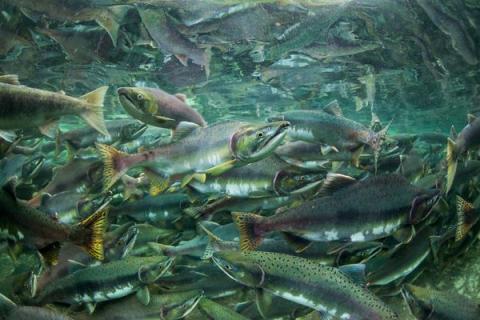
Too Many Salmon in the Sea
Pink salmon (shown above spawning in Alaska) have increased since the 1970s, with an estimated 640 million returning to their breeding rivers in Asia and North America in 2009 alone.
Along with other salmon, pink salmon (Oncorhynchus gorbuscha) numbers have grown since the 1970s, with an estimated 640 million returning to their breeding rivers in Asia and North America in 2009 alone. (Read "The Long Journey of the Pacific Salmon" in National Geographic magazine.).
Tied to rising ocean temperatures in the Bering Sea and North Pacific that spurred the growth of the prey of salmon and seabirds alike, the "much larger than previously known" impact of pink salmon is reported in a new Proceedings of the National Academy of Sciences report.
It's "an uncommon case of too many fish in the sea," says the report. The study, led by Alan Springer of the University of Alaska Fairbanks, found that salmon eating the food of seabirds appears to be cutting the birds' numbers.
Too many fish in the sea? Surging pink salmon stocks in the Pacific Ocean pose a risk to other wildlife, suggests a seabird study released on Monday that points to climate change as a culprit. (Related video: "Alaskan Salmon Adventure.")
Along with other salmon, pink salmon (Oncorhynchus gorbuscha) numbers have grown since the 1970s, with an estimated 640 million returning to their breeding rivers in Asia and North America in 2009 alone. (Read "The Long Journey of the Pacific Salmon" in National Geographic magazine.)
Tied to rising ocean temperatures in the Bering Sea and North Pacific that spurred the growth of the prey of salmon and seabirds alike, the "much larger than previously known" impact of pink salmon is reported in a new Proceedings of the National Academy of Sciences report.
It's "an uncommon case of too many fish in the sea," says the report. The study, led by Alan Springer of the University of Alaska Fairbanks, found that salmon eating the food of seabirds appears to be cutting the birds' numbers.
Too many fish in the sea? Surging pink salmon stocks in the Pacific Ocean pose a risk to other wildlife, suggests a seabird study released on Monday that points to climate change as a culprit. (Related video: "Alaskan Salmon Adventure.")Too many fish in the sea? Surging pink salmon stocks in the Pacific Ocean pose a risk to other wildlife, suggests a seabird study released on Monday that points to climate change as a culprit. (Related video: "Alaskan Salmon Adventure.")
Along with other salmon, pink salmon (Oncorhynchus gorbuscha) numbers have grown since the 1970s, with an estimated 640 million returning to their breeding rivers in Asia and North America in 2009 alone. (Read "The Long Journey of the Pacific Salmon" in National Geographic magazine.)
Tied to rising ocean temperatures in the Bering Sea and North Pacific that spurred the growth of the prey of salmon and seabirds alike, the "much larger than previously known" impact of pink salmon is reported in a new Proceedings of the National Academy of Sciences report.
It's "an uncommon case of too many fish in the sea," says the report. The study, led by Alan Springer of the University of Alaska Fairbanks, found that salmon eating the food of seabirds appears to be cutting the birds' numbers.
~
